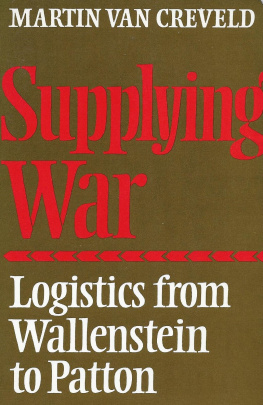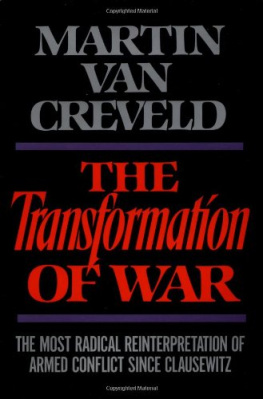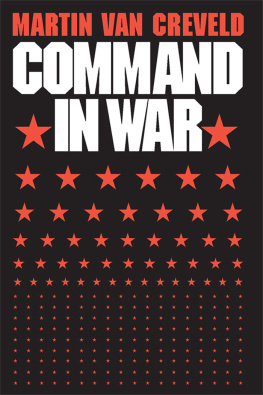Martin Van Creveld - Supplying War: Logistics From Wallenstein to Patton
Here you can read online Martin Van Creveld - Supplying War: Logistics From Wallenstein to Patton full text of the book (entire story) in english for free. Download pdf and epub, get meaning, cover and reviews about this ebook. year: 1977, publisher: Cambridge University Press, genre: History. Description of the work, (preface) as well as reviews are available. Best literature library LitArk.com created for fans of good reading and offers a wide selection of genres:
Romance novel
Science fiction
Adventure
Detective
Science
History
Home and family
Prose
Art
Politics
Computer
Non-fiction
Religion
Business
Children
Humor
Choose a favorite category and find really read worthwhile books. Enjoy immersion in the world of imagination, feel the emotions of the characters or learn something new for yourself, make an fascinating discovery.
- Book:Supplying War: Logistics From Wallenstein to Patton
- Author:
- Publisher:Cambridge University Press
- Genre:
- Year:1977
- Rating:3 / 5
- Favourites:Add to favourites
- Your mark:
- 60
- 1
- 2
- 3
- 4
- 5
Supplying War: Logistics From Wallenstein to Patton: summary, description and annotation
We offer to read an annotation, description, summary or preface (depends on what the author of the book "Supplying War: Logistics From Wallenstein to Patton" wrote himself). If you haven't found the necessary information about the book — write in the comments, we will try to find it.
Supplying War: Logistics From Wallenstein to Patton — read online for free the complete book (whole text) full work
Below is the text of the book, divided by pages. System saving the place of the last page read, allows you to conveniently read the book "Supplying War: Logistics From Wallenstein to Patton" online for free, without having to search again every time where you left off. Put a bookmark, and you can go to the page where you finished reading at any time.
Font size:
Interval:
Bookmark:
Published by the Press Syndicate of the University of Cambridge
The Pitt Building, Trumpington Street, Cambridge CB2 1RP
32 East 57th Street, New York, NY 10022, USA 296 Beaconsfield Parade, Middle Park Melbourne 3206, Australia
Cambridge University Press 1977
First published 1977
Reprinted 1978
First paperback edition 1980
Printed in the United States of America
Typeset in Great Britain by
Western Printing Services Ltd, Bristol
Printed and bound by Vail-Ballou Press, Inc.,
Binghamton, New York
Library of Congress Cataloguing in Publication Data
Van Creveld, Martin L
Supplying war.
Bibliography: p
1. Logistics-History. 2. Military art and science- History.
3. Military history, Modem. I. Title.
ul68.V36 355.41094 77-5550 ISBN 0 521 21730 X hardcovers
ISBN 0 521 29793 1 paperback
To Louis and Francien Wifler
This study owes its existence to a book, The Blitzkrieg Era and the German General Staff, 1865-1941, by Larry H. Addington, which first excited my interest in logistics. Professor Addington has also kindly answered some queries, as did Mr David Chandler and Mr Christopher Duffy, both of the Department of Military History, Sandhurst. I owe a debt of gratitude to Professor Laurence Martin and Mr Brian Bond, of Kings College, London, for aid and encouragement. Material for Chapter 7 was made available on behalf of the Liddell Hart Centre for Military Archives by Lady Kathleen Liddell Hart, for whose kind hospitality I am most grateful. Some financial support during my stay in London came from the British Council.
Above all, however, I thank Rachel my wife; it was she who typed out some of the chapters, and suffered for the rest.
M. v. C.
London, 28 July 1976
Logistics are defined by Jomini as the practical art of moving armies under which he also includes providing for the successive arrival of convoys of supplies and establishing and organizing... lines of supplies. Putting these together, one arrives at a definition of logistics as the practical art of moving armies and keeping them supplied, in which sense the term is used in this study. The aim of the study is to arrive at an understanding of the problems involved in moving and supplying armies as affected through time by changes in technology, organization and other relevant factors; and, above all, to investigate the effect of logistics upon strategy during the last centuries.
Strategy, like politics, is said to be the art of the possible; but surely what is possible is determined not merely by numerical strengths, doctrine, intelligence, arms and tactics, but, in the first place, by the hardest facts of all: those concerning requirements, supplies available and expected, organization and administration, transportation and arteries of communication. Before a commander can even start thinking of manoeuvring or giving battle, of marching this way and that, of penetrating, enveloping, encircling, of annihilating or wearing down, in short of putting into practice the whole rigmarole of strategy, he has - or ought - to make sure of his ability to supply his soldiers with those 3,000 calories a day without which they will very soon cease to be of any use as soldiers; that roads to carry them to the right place at the right time are available, and that movement along these roads will not be impeded by either a shortage or a superabundance of transport.
It may be that this requires, not any great strategic genius but only plain hard work and cold calculation. While absolutely basic, this kind of calculation does not appeal to the imagination, which may be one reason why it is so often ignored by military historians. The result is that, on the pages of military history books, armies frequently seem capable of moving in any direction at almost any speed and to almost any distance once their commanders have made up their minds to do so. In reality, they cannot, and failure to take cognizance of the fact has probably led to many more campaigns being ruined than ever were by enemy action.
Though it has been claimed that civilian historians are especially prone to overlook the role of logistics, the present author has not found this fault confined to any class of writers. Napoleons tactics and strategy have attracted whole swarms of theoreticians, historians, and soldiers who between them were able to show that both were natural, indeed necessary, outgrowths of previous developments. The one field of Napoleonic warfare that is still believed to have been fundamentally different from anything that went previously is the logistic one, which is itself enough to suggest that the subject has been neglected. Similarly, no one has yet made a detailed study of the arrangements that made it possible to feed an ambulant city with a population of 200,000 while simultaneously propelling it forward at a rate of fifteen miles a day. To take another example: though Rommels supply difficulties in 1941-2 are probably mentioned as a crucial factor in his fall by every one of the enormously numerous volumes dealing with him, no author has yet bothered to investigate such questions as the number of lorries the Africa Corps had at its disposal or the quantity of supplies those lorries could carry over a given distance in a given period of time.
Even when logistic factors are taken into account, references to them are often crude in the extreme. A glaring instance is Liddell Harts criticism of the Schlieffen Plan which, while concentrating on logistic issues, does so without considering the consumption and requirements of the German armies, without saying a word about the organization of the supply system, without even a look at a detailed railway map. All we find is a passage about the circumference of a circle being longer than its radii, which reminds one suspiciously of that geometrical system of strategy so beloved of eighteenth-century military writers. And this passage is put forward by some, and accepted by others, as proof that the Schlieffen Plan, the details of which took scores of highly-trained general staff officers half a generation to work out, was logistically impracticable!
Clearly, this will not do. Instead, the present study will ask the fundamental questions: what were the logistic factors limiting an armys operations? What arrangements were made to move it and keep it supplied while moving? How did these arrangements affect the course of the campaign, both as planned and as carried out? In case of failure, could it have been done? Wherever possible, as in Chapters 5, 6, and 7, an attempt is made to answer these questions on the basis of concrete figures and calculations, not on vague speculations. Yet even where, as is often the case, the sources available make it impossible to go into such detail, one can at least analyse the main logistic factors at work and assess their effect on strategy. And one can do this without adhering to stereotypes such as eighteenth-century magazine chained or Napoleonic predatory warfare.
An undertaking to study logistics and its influence on strategy during the last century and a half is very ambitious. To compress the topic into the space of a single book, and yet avoid mere generalities, this narrative concentrates on a number of campaigns between 1805 and 1944 (with an introductory chapter on the seventeenth and eighteenth centuries) selected to present different aspects of the problem. Thus, the Ulm campaign is commonly regarded as the most successful example ever of an army living off the country, whereas that of 1812 represents an attempt to utilize horse-drawn transport in order to cope with a problem that was too big to be solved - if it could be solved at all - by anything but the means offered by the modern industrial era. The Franco-Prussian war of 1870, of course, is said to have witnessed a revolution in the use of the railway for military purposes, while 1914 allows a glimpse into the limits of what could be achieved by that means of transportation. The German campaign against Russia in 1941 is interesting as a problem in the transition towards a wholly mechanized army; whereas, in the Allied forces of 1944, that transition had been completed. Finally, Rommels Libyan campaigns of 1941 and 1942 present some aspects worth studying because unique. From beginning to end, we shall be concerned with the most down-to-earth factors - subsistence, ammunition, transport - rather than with any abstract theorizing; with what success, remains for the reader to judge.
Font size:
Interval:
Bookmark:
Similar books «Supplying War: Logistics From Wallenstein to Patton»
Look at similar books to Supplying War: Logistics From Wallenstein to Patton. We have selected literature similar in name and meaning in the hope of providing readers with more options to find new, interesting, not yet read works.
Discussion, reviews of the book Supplying War: Logistics From Wallenstein to Patton and just readers' own opinions. Leave your comments, write what you think about the work, its meaning or the main characters. Specify what exactly you liked and what you didn't like, and why you think so.














